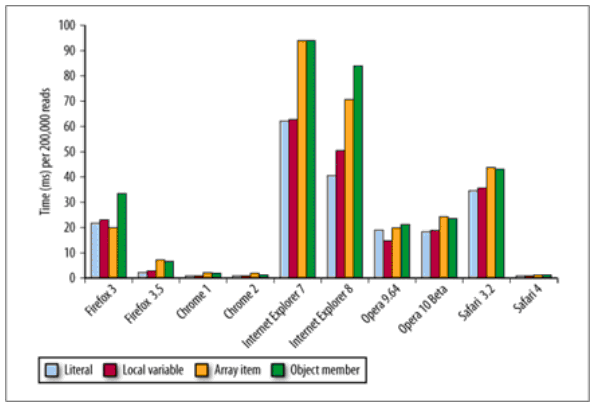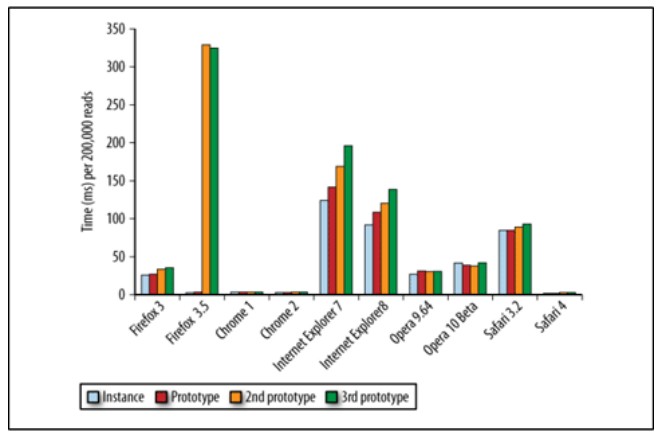
Local variables can also be understood as variables defined inside the function. It is obvious that accessing local variables is faster than variables outside the scope, because it is located in the first variable object of the scope chain (for an introduction to the scope chain, you can read this articles). The deeper a variable is in the scope chain, the longer it takes to access it. Global variables are always the slowest because they are the last variable object in the scope chain.
Access to each data type requires a performance price. Direct quantities and local variables are basically affordable, while accessing array items and object members is more expensive. The figure below shows the time it took for different browsers to perform 200'000 operations on these four data types.

 Another advanced usage of objects is simulated classes and inherited classes. I like to call objects used in this way object classes. Inheriting object classes is mainly accomplished by relying on the prototype chain. There are too many knowledge points that require additional detailed explanation. Through the above object member search process, the speed of accessing object members becomes slower as the prototype chain goes deeper. The following figure shows the relationship between the depth of an object member in the prototype chain and the access time:
Another advanced usage of objects is simulated classes and inherited classes. I like to call objects used in this way object classes. Inheriting object classes is mainly accomplished by relying on the prototype chain. There are too many knowledge points that require additional detailed explanation. Through the above object member search process, the speed of accessing object members becomes slower as the prototype chain goes deeper. The following figure shows the relationship between the depth of an object member in the prototype chain and the access time:
 Okay, to sum it up in one sentence: the deeper a property or method is in the prototype chain, the slower it is to access it. The solution is to store frequently used object members, array items and variables outside the scope into local variables, and then access this local variable.
Okay, to sum it up in one sentence: the deeper a property or method is in the prototype chain, the slower it is to access it. The solution is to store frequently used object members, array items and variables outside the scope into local variables, and then access this local variable.
 What are the methods of remote computer maintenance?
What are the methods of remote computer maintenance?
 How to solve the problem of garbled characters when opening a web page
How to solve the problem of garbled characters when opening a web page
 js method to generate random numbers
js method to generate random numbers
 What are the rpc frameworks?
What are the rpc frameworks?
 How to export project in phpstorm
How to export project in phpstorm
 How to check server status
How to check server status
 How to restore mysql database
How to restore mysql database
 How to solve the problem that Win10 folder cannot be deleted
How to solve the problem that Win10 folder cannot be deleted




